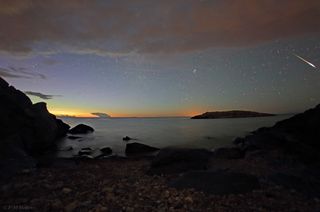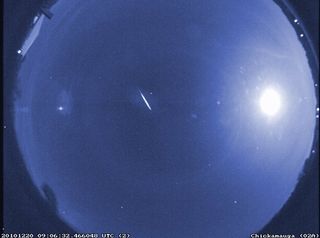
The 2014 Perseid meteor shower — a usually spectacular celestial showcase — might be washed out by the light of a nearly full moon rising at the same time as the shower's peak in August.
This year's Perseid meteor display peaks early on Aug. 13, but as luck would have it, the moon will be a bright gibbous phase, just three days past full at that same time. As a result, it will probably not be possible to see many "shooting stars."
The meteor display is known as the Perseid meteor shower because it appears to radiate out from the constellation of Perseus, located high in the northeast sky during predawn hours. Most of the shower's meteors appear before dawn, but unfortunately, the moon will be lurking nearby in the constellation of Pisces at that time. Earth's natural satellite will be above the horizon for much of the night, likely squelching views of most of the meteor streaks with its bright light.
Normally, under a clear, dark sky free of any bright moonlight, a skywatcher would expect to see stars down to magnitude 6.5 — considered to be the threshold marking the dimmest stars visible to the naked eye. With dark sky conditions on the peak night of the Perseids, you might expect to see as many as 90 to 100 meteors per hour. [Amazing Perseid Meteor Shower Photos of 2013]
But thanks to the brightness of the full moon during the meteor shower's peak this year, observers will probably only be able to see about one-tenth as many meteors as they could see under darker conditions. Plus, local light pollution can also hamper a person's ability to see the brilliant streaks of light.

Hope is not lost
This doesn't mean that intrepid observers won't see any meteors, however. Perseid activity should be good enough for some meteors to overcome the brightness of the moon. In his annual Astronomical Calendar publication for 2014, editor Guy Ottewell notes that: "Many (Perseids) are bright; white, yellow, green, red, orange; leave spectacular long-lasting trains; end in flares."
And you can escape the moon by watching early. A good number of Perseids can be seen during the first week of August, in the hours between moonset and the beginning of morning twilight.
Get the Space.com Newsletter
Breaking space news, the latest updates on rocket launches, skywatching events and more!
On the morning of August 8, for example, five days before maximum, there will be about 45 minutes of darkness between moonset and the first light of dawn. On the morning of Aug. 7 there will be about 140 minutes, and on Aug. 6, there should be about 2.5 hours of moonless dark.
In addition to the Perseids, there are about a half-dozen other minor meteor showers that occur from late July into mid-August. Perhaps these minor showers will get more attention this year, as conditions for observing them are relatively favorable compared to the Perseids.
Editor's Note: If you have an amazing night sky photo of the Perseid meteor shower or any other night sky view that you'd like to share for a possible story or image gallery, please contact managing editor Tariq Malik at spacephotos@space.com.
Joe Rao serves as an instructor and guest lecturer at New York's Hayden Planetarium. He writes about astronomy for Natural History magazine, the Farmer's Almanac and other publications, and he is also an on-camera meteorologist for News 12 Westchester, N.Y.Follow us @Spacedotcom, Facebookand Google+. Original article on Space.com.
Join our Space Forums to keep talking space on the latest missions, night sky and more! And if you have a news tip, correction or comment, let us know at: community@space.com.

Joe Rao is Space.com's skywatching columnist, as well as a veteran meteorologist and eclipse chaser who also serves as an instructor and guest lecturer at New York's Hayden Planetarium. He writes about astronomy for Natural History magazine, the Farmers' Almanac and other publications. Joe is an 8-time Emmy-nominated meteorologist who served the Putnam Valley region of New York for over 21 years. You can find him on Twitter and YouTube tracking lunar and solar eclipses, meteor showers and more. To find out Joe's latest project, visit him on Twitter.
